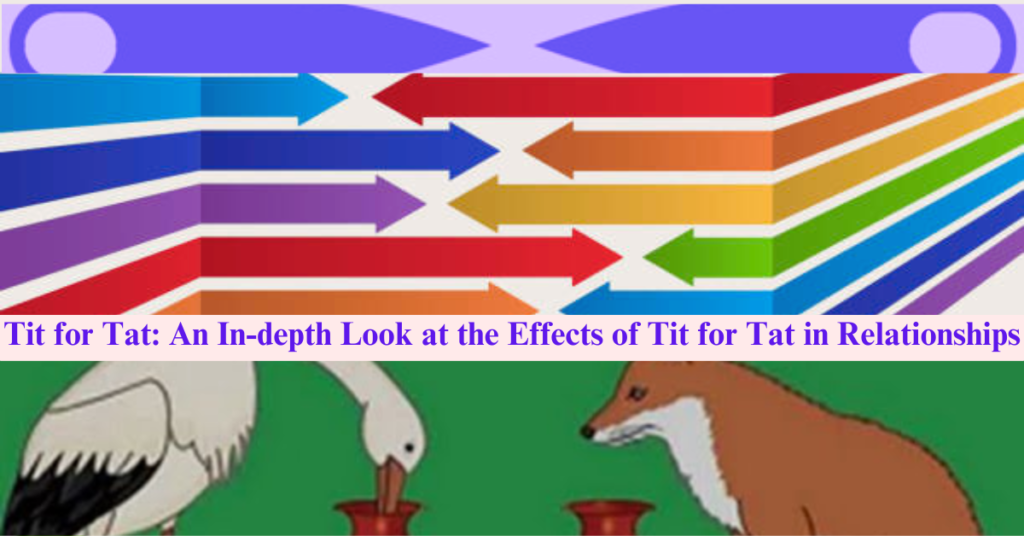Tit for Tat: In relationships, “Tit for Tat” refers to the practice of responding to someone’s actions—whether positive or negative—with a similar action. It often involves matching behavior, where kindness is met with kindness, and negativity is met with retaliation, creating a cycle of reciprocation that can either strengthen or strain the relationship.

Tit for Tat: An In-depth Look at the Effects of Tit for Tat in Relationships
Table of Contents
Tit for Tat: An In-depth Look at the Effects of Tit for Tat in Relationships

The principle of “tit for tat,” or “tit for tat,” is deeply rooted in Indian society and refers to the spirit of reciprocity in human relationships. This idea, which seems simple, actually deeply impacts relationships at the individual, familial, societal, and global levels. The impact of this principle can be seen both positively and negatively, depending on how and in what situation it is being applied. In this article, we will take a deeper look at the principle of “tit for tat,” understand its various aspects, and try to understand how it makes or breaks human relationships.
Reciprocity: A Fundamental Element of Human Nature
Reciprocity is an essential part of human nature. This ideology is based on the principle of how we react to others and how our actions impact their actions. The principle of reciprocity not only shapes our individual relationships, but it also operates on a broader level of society. When we are kind to someone, we often expect that person to respond in kind. Similarly, if someone treats us badly, we have a natural inclination to reciprocate. This is the basic idea of “tit for tat.”
Positive reciprocity and its benefits
When the principle of reciprocity is applied in a positive way, it can be extremely beneficial in human relationships. Positive reciprocity is the process in which people perform positive actions toward each other and the outcome of these actions is positive. It can be expressed through kindness, support, and mutual respect. When two people demonstrate kindness and respect toward each other, a strong and lasting bond is formed between them.
For example, in a friendship, if one friend helps another, the other friend is naturally willing to help him or her at some point. This cycle of kindness deepens and strengthens the bond between the two. Similarly, in a love relationship, when both partners respect each other and value their feelings, the bond is strengthened.
The effect of positive reciprocity is not limited to personal relationships. It can also be effective in the workplace. When co-workers support each other and contribute to each other’s success, it not only improves their personal relationships, but it also improves the productivity and overall atmosphere of the organization. Through positive reciprocity, a supportive and collaborative workplace can be created, where people are motivated to help each other and contribute to achieving the organization’s goals.
Negative reciprocity and its dangers
However, the principle of “tit for tat” does not always yield positive results. When it is applied in a context of negativity, it can take the form of a destructive cycle. Negative reciprocity is the process in which people behave negatively towards each other, and this behaviour creates a chain of action-reaction. Suppose, a person feels that he has been wronged, he may do the same type of act in retaliation. This type of behaviour often increases the tension between both the parties and can make the situation even worse.
In families, this cycle can lead to long-lasting disputes. For example, if one member behaves harshly towards another due to a small difference of opinion, the other member may also behave in the same way. Gradually this small matter takes the form of a big resentment and creates a permanent distance between the family members.
Take the example of a family quarrel where a brother or sister gets angry over a small matter. If this resentment is responded to with even more harshness, it can deepen the rift between them. Gradually, this quarrel can increase so much that both the siblings even stop talking to each other. This situation not only harms their personal relationships but also creates difficulties for other family members.
In workplaces, the principle of ‘tit for tat’ can create a toxic environment among employees. If one employee interferes with the work of another employee or tries to undermine his efforts, the other employee tries to do the same in response. The result is that the workplace environment becomes tense and unbearable, leading to a decrease in productivity and cooperation.
Social and Global Impact of ‘Tit for Tat’
The principle of “tit for tat” is not limited to personal and family relationships. Its impact can also be seen at the social and global level. In society, this principle affects the relationship between different groups and communities. When one community behaves negatively towards another, the other community also responds in the same way. The result is that division and tension increase in society.
For example, tit for tat politics is commonly seen among political parties. When a political party makes harsh statements against another party or attacks its policies, the other party also responds in the same manner.
On a global level, the principle of “tit for tat” also affects relations between countries. In international relations, if one country takes a harsh step against another country, the other country may respond in a similar way. This can lead to international tension and conflict. For example, trade wars and military conflicts are often the result of a “tit for tat” policy.
The need to break the cycle
It is true that the tendency to respond in a similar way is natural, but it is not always the best option. Emotional intelligence and understanding is needed to break this cycle of tit for tat. Instead of responding to negativity with more negativity, one must get to the root of the problem and work towards a solution through dialogue and understanding.
In personal relationships, this type of approach encourages open dialogue, in which both parties express their feelings and opinions clearly. Through such dialogue, both parties can understand each other’s point of view and reach a meaningful solution. It not only improves relationships but also increases stability and trust in them.
For example, a married couple may have a dispute over an issue. If they try to resolve this dispute with a tit for tat approach, it may create a rift in their relationship. Instead, if they openly share their thoughts and feelings and try to understand each other’s point of view, they can resolve this dispute and make their relationship even stronger.
At the workplace too, communication and understanding are important to create a supportive and collaborative environment. If colleagues behave negatively towards each other, it may create a tense atmosphere, which affects the productivity of the organization. Instead, if colleagues try to understand each other’s ideas and perspectives, they can cooperate better and succeed in achieving the goals of the organization.
Importance of Apology
Apology is the means through which the cycle of ‘tit for tat’ can be broken. Forgiveness does not mean that you are admitting to an injustice, but it is a way of getting free from the burden that keeps you tied to past events. When a person apologizes or forgives, he ends the cycle of negativity that was between him and the other person. It provides an opportunity for a fresh start, where both parties can move forward without any resentment.
In relationships, practicing forgiveness not only strengthens them, but also makes them more resilient. It is also an important part of personal growth, as it teaches us how to move on from past mistakes and negative experiences.
For example, if a friend has hurt another friend unintentionally, apologizing and forgiving him can be the first step to making their relationship better again. The process of giving and accepting forgiveness not only reunites the relationship, but also makes it stronger.
Measures to improve the ‘tit for tat’ policy
To improve the ‘tit for tat’ policy, we need to understand ourselves better and control our emotions and reactions. For this, it is important to develop emotional intelligence. Emotional intelligence means recognizing your emotions, understanding them, and controlling them in a positive direction.
Along with this, we should develop the habit of stopping and thinking about our reactions in time. When we feel resentment or negativity in a situation, we need to pause and think for a while instead of reacting immediately. This can help us better control our reactions and handle the situation more positively.
Conclusion
“Tit for tat” is a principle that deeply affects human relationships. It reflects the power of reciprocity, where our actions have a direct impact on our relationships. This principle can strengthen relationships in a positive way, but in a negative way it can also destroy them. Through understanding, communication, and forgiveness, this negative cycle can be broken, and this can lead to healthier, more balanced, and happier relationships.
Ultimately, it is our personal choice whether we respond to negativity with negativity or whether we enrich our relationships through understanding and positivity. The principle of “tit for tat” is a reminder that our actions impact not only our relationships but also the broader fabric of society in which we live.
The principle of “tit for tat” in relationships acts like a mirror, a reflection of our actions. It forces us to think about how our actions impact others and how we can turn this impact in a positive direction. Success in relationships requires that we handle our reactions with understanding and sensitivity, so that we can build more healthy and lasting relationships in our lives.


